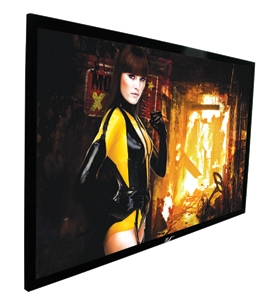Building a Serious Home Theater for $3k Page 2

Living On The Cheap
Let's start with the projector, which I found nothing short of amazing. The H1080 delivers real, honest-to-goodness 1080p video, with detail that competes with any projector I've tried. I found the picture vivid and involving, whether I was watching action junk like Peter Jackson's King Kong or old episodes of The A-Team streamed via Netflix.
What the H1080 doesn't give you are gain and bias controls for red, green, and blue, which means you can't do a proper calibration. But there's little need for it. After merely selecting the Movie mode and adjusting the brightness and contrast controls, I measured an average color temperature of 6,702 kelvins, a barely noticeable 200 degrees above the industry standard of 6,500 kelvins. The video processing looks surprisingly good; the only artifact noticeable on normal program material was a bit of noise. (Turning on the projector's noise-reduction processing barely had any effect.)
The Vivitek's weak point is contrast, which measured a low 710:1 after adjustment. However, a gray screen goes a long way toward fixing that. And with a maximum output of 22.73 footlamberts, this projector will still look plenty bright on that Elite CineGrey. Picture uniformity at very low levels also isn't good; when it fades to black, the image's upper right corner looks reddish and the lower left looks bluish.
Although the Hsu Research STF-2 sounded awesome from the very first note, the Infinity Primus P152s proved cantankerous. The speaker sounded fairly smooth and imaged pretty well, but it exhibited a glaringly bright tonal balance. Measurement confirmed what my ears told me: Response jumps up by 3 to 4 dB from 600 to 8,000 Hz, then rises another 4 to 7 dB between 8 and 20 kHz. The brightness made voices sound harsh enough to hurt my ears when I cranked the system up. Fortunately, the receiver offered an easy fi x (or so I thought).
The VSX-1019AH-K includes Pioneer's MCACC (Multi-Channel Acoustic Calibration) system, which compensates for flaws in your speakers and your room acoustics. I figured MCACC might tame the P152's brightness, but after connecting the MCACC microphone and running the program, I got mixed results.
Fortunately, the VSX-1019AH-K let me tweak the MCACC settings to a degree I've never before encountered, which is astounding for a $499 receiver. I soon stumbled upon its X-Curve feature, which attenuates frequencies above 2 kHz. With X-Curve set for a 2-dB/octave treble rolloff, the P152 suddenly sounded like a great budget speaker. The sound wasn't what I'd call detailed or delicate, but the tonal balance was right on, and to me that's the most important thing.
Cheap Thrills
Finally, the $3K system was giving me the thrill ride I hoped for. Even when watching Watchmen - a tour de force of stupid action - I never got the sense I was using one of the least expensive component home theater systems one could possibly assemble.
The vivid colors and crisp details of Watchmen's over-the-top visual effects came through beautifully; only in the darkest scenes did I notice the H1080's so-so black level. Even at bombastic levels, I never heard distortion from the P152s or the Hsu STF-2. The STF-2 delivered a satisfying, massaging experience as it pressurized my 3,100-cubic-foot home theater, and the Pioneer's MCACC smoothed out minor flaws of the sub and my room's acoustics. I also enjoyed flicking through dozens of music tracks from my iPod while comfortably lounging in my recliner - and was delighted to see the cover art appear onscreen along with the artist, album, and song names.
But you won't match this performance unless you defend the integrity of your home-theater space with all the vigilance of a mother grizzly. Getting the best possible experience may require you to do some things that others might consider unsettling. For example, you'll get better contrast by painting the walls and ceiling of your theater black, and installing black or dark gray carpeting. You'll get better contrast still by putting blackout shades (or black-painted plywood) over the windows. You can get better sound by sticking a half-dozen 1-foot squares of 4-inch-thick wedge foam on each side wall between the speakers and your listening chair.
None of these "furnishings" will look good, but those who care about such things can go watch their stylish, skinny flat-panel TVs somewhere else. This room is for you - and anyone else who understands that there are times when you gotta put performance first.
- Log in or register to post comments





























































